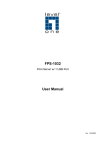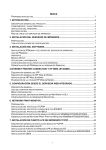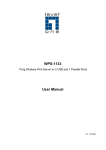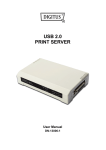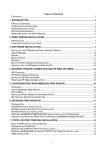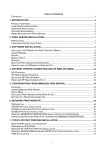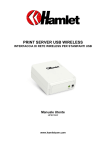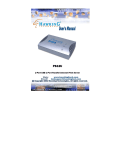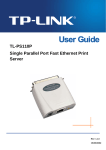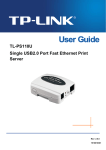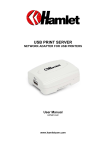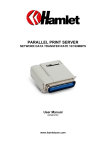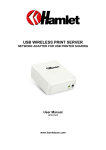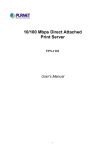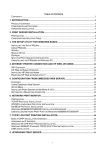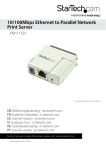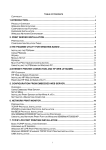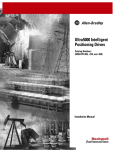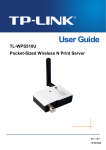Download Zonet Technology Zonet ZPW4000 User's Manual
Transcript
TABLE OF CONTENTS
1.
INTRODUCTION .................................................................................................. 1
PRODUCT OVERVIEW ........................................................................................................ 1
WIRELESS SPECIFICATIONS ................................................................................................ 1
COMPONENTS AND FEATURES .............................................................................................. 2
HARDWARE INSTALLATION ................................................................................................. 3
NETWORK ENVIRONMENT ................................................................................................... 4
WIRED NETWORK WITH PRINT SERVER: ................................................................................. 4
WIRELESS NETWORK WITH PRINT SERVER: ............................................................................. 4
INFRASTRUCTURE (ACCESS POINT) MODE:.............................................................................. 4
AD-HOC (PEER-TO-PEER) MODE: ...................................................................................... 4
2.
PRINT SERVER INSTALLATION............................................................................ 5
PREPARATION ................................................................................................................ 5
CONFIGURATION SOLUTION TABLE ........................................................................................ 5
3. SOFTWARE INSTALLATION...................................................................................... 7
INSTALLING THE PSADMIN AND PRINT SERVER’S DRIVER ............................................................. 7
USING PSADMIN ...........................................................................................................22
WIZARD ......................................................................................................................22
MANUAL SETUP .............................................................................................................25
REFRESH .....................................................................................................................28
MULTIPLE PRINT QUEUES CONFIGURATION (NOVELL NETWARE) ....................................................28
UNINSTALLING THE PSADMIN ON WINDOWS PC ......................................................................29
4. INTERNET PRINTER CONNECTION AND HP WEB JETADMIN................................... 30
IPP OVERVIEW ..............................................................................................................30
HP WEB JETADMIN OVERVIEW ...........................................................................................32
INSTALLING HP WEB JETADMIN ..........................................................................................32
REMOVING HP WEB JETADMIN UTILITY .................................................................................33
5. CONFIGURATION FROM EMBEDDED WEB SERVER ................................................. 34
OVERVIEW ...................................................................................................................34
USING EMBEDDED WEB SERVER .........................................................................................34
SETUP MENU ................................................................................................................43
INSTALLING PRINT SERVER ON NETWARE 4.X/5.X ....................................................................50
SETTING UP A MACINTOSH COMPUTER (MAC 8.X/9.X)...............................................................53
PREPARATION ...............................................................................................................57
TCP/IP PROTOCOL INSTALLATION .......................................................................................58
IPX/SPX-COMPATIBLE PROTOCOL INSTALLATION .....................................................................58
NETBEUI PROTOCOL INSTALLATION (9X/ME/NT4/2000) .........................................................59
WINDOWS 2000/XP/2003 MANUAL INSTALLATION PROCEDURE ...................................................59
UNINSTALLING NETWORK PRINT PORT ON WINDOWS 2000/XP/2003............................................61
7. TCP/IP LPR PORT PRINTING INSTALLATION......................................................... 63
BASIC TCP/IP INSTALLATION OVERVIEW ...............................................................................63
ASSIGNING AN IP ADDRESS ..............................................................................................63
WINDOWS NT LPR PORT PRINTING INSTALLATION ...................................................................63
WINDOWS 2000/XP/2003/VISTA/7 STANDARD TCP/IP PORT PRINTING INSTALLATION .....................65
UNIX INSTALLATION .......................................................................................................68
8. UPGRADING PRINT SERVER ............................................................................................73
OVERVIEW ...................................................................................................................73
UPGRADING THE PRINT SERVER FROM PSADMIN .......................................................................73
UPGRADING THE PRINT SERVER FROM WINDOWS 2000/XP/2003/VISTA/7 (THROUGH TCP/IP) ............73
UPGRADING THE PRINT SERVER FROM UNIX (THROUGH TCP/IP) ..................................................74
UPGRADING THE PRINT SERVER FROM BROWSER .......................................................................74
9. TROUBLESHOOTING .............................................................................................. 76
GENERAL TROUBLESHOOTING OVERVIEW................................................................. 76
POWER RELATED PROBLEMS ..............................................................................................76
PRINT PORT RELATED PROBLEMS .........................................................................................77
WINDOWS 2000/XP TROUBLESHOOTING ..............................................................................77
MOVING THE PRINT SERVER TO A NEW SEGMENT ......................................................................78
MOVING YOUR COMPUTER TO A NEW SEGMENT .......................................................................80
NOVELL NETWARE TROUBLESHOOTING..................................................................................80
TCP/IP TROUBLESHOOTING ..............................................................................................80
APPENDIX ................................................................................................................. 83
FREQUENTLY ASKED QUESTIONS .........................................................................................88
ADDITIONAL INSTALLATION INSTRUCTIONS.............................................................................90
Copyright Statement
is the registered trademark of Zonet Technology Inc. All the
products and product names mentioned herein are the trademarks or registered
trademarks of their respective holders. Copyright of the whole product as
integration, including its accessories and software, belongs to Zonet Technology
Inc. Without the permission of Zonet Technology Inc., any individual or party is
not allowed to copy, plagiarize, imitate or translate it into other languages.
802.11n Wireless Print Server User Manual
1.Introduction
Product Overview
The external print servers enhance capability by letting you place your printers at
convenient locations directly on the Ethernet network, and by increasing network
printer performance and management. Please note that the print server does not
support printing with host-based printers, e.g. CAPT, GDI, PPA.
Network Management
The print servers support the Simple Network Management Protocol (SNMP),
which remote printer management and a warning. A standard SNMP agent is
permanent on these print servers. Any standard SNMP-based application can be
used to access and manage these
print servers.
Network configuration
The print servers provide an embedded web server that can be accessed via a
proper web browser. We also subsidiary Windows-based PSAdmin utility which
help administrator to setup print server environment.
Wireless Specifications
Standard
Radio Frequency
Complies with IEEE 802.11b/g/n standard
2.4Ghz ISM Band
Media Access Control
Method
Carrier Sense Multiple Access / Collision Avoidance
(CSMA/CA) with ACK
Modes
Ad-Hoc and Infrastructure (User definable)
Data Transfer Rate
Output Power
Wireless Security
1, 2, 5.5, 6, 9, 11, 12, 18, 24, 36, 48, 54, 108Mbps
15 ~ 20dBm
WEP(64bit/128bit) and WPA/WPA2
1
802.11n Wireless Print Server User Manual
Components and Features
802.11n Wireless Print Server
˙1 USB2.0 port
˙Fast Ethernet network port: RJ-45 for 10Base-T or 100Base-TX
˙1 LED to indicate Status: Orange
˙1 LED to indicate USB port: Green
˙1 LED to indicate WLAN status: Orange
˙Built-in WPS Button
˙Built-in Reset Button
˙One Setup CD for Windows 2000/XP/2003/Vista/7, User Guide
˙One external AC power adapter
˙One Quick Installation Guide
LED Indicators
LED
State
On (Orange)
Status
USB
WLAN
Indication
When power switched on, the Status indicator will
flash five times, and then on. The LAN port is linking
also
Flashing (one time
When power switched on but LAN port is not linking
per second)
Flashing (several
Data transmitting
times per second)
On (Green)
Connect with USB2.0 printer
On(Orange)
WLAN enabled
Flashing
Data transmitting
Before you start, you should prepare the following items:
One Windows-based computer with print server setup CD
One printer with a USB port
One USB printer cable
802.11n Wireless Print Server User Manual
Hardware Installation
To install the print servers, you need to complete these steps:
˙Confirm that your printer USB port works well.
˙Connect the print server to the network and printer, and plug in the print server.
Follow these instructions to install the print servers, please refer to any
peripheral
you are connecting to the print server:
1.
Turn off the printer’s power.
2.
Connect the print server to your printer with the USB cable.
3.
Turn the printer’s power on.
4.
Plug the AC power adapter into the power connector on the print server.
5.
Wait 10 seconds until all the LEDs have stopped flashing. (the WLAN LED
will continue to flash if data is being transmitted via wireless connectivity).
Note: The Status LED should be flash five times when POST. If not, please
contact your local dealer for repair or replacement. Then WLAN LED should
be on to associate with the proper Access Point with best wireless signal. If
not, please contact your local dealer for repair or replacement
WPS
WiFi Protected Setup
Printer Server supports WiFi Protected Setup (WPS), which is an easy way to set
up a secure wireless network. WPS is an industry standard specification, defined
by the WiFi Alliance.
WPS allows you to quickly set up a wireless network with strong security, without
having to configure security settings manually. Each WPS connection works
between two devices. Both devices must support WPS (check each device’s
documentation to make sure).
1. Press WPS buttons in each of the device itself and Wireless AP in three seconds
and release it, then the WLAN LED of device will be off.
2. Wait two minutes to find another device that also has WPS activated. Then, the
two devices connect and set up a secure network by themselves.
3
802.11n Wireless Print Server User Manual
Network Environment
Wired Network with Print Server:
Wireless Network with Print Server:
Infrastructure (Access Point) Mode:
Ad-Hoc (PEER-to-PEER) Mode:
4
802.11n Wireless Print Server User Manual
2. Print Server Installation
Preparation
To meet users’ network printing needs in today’s heterogeneous and multiple
protocol networking environments, the print server supports industrial standard
protocols, including TCP/IP, IPX/SPX, NetBEUI and AppleTalk. This means that the
print server supports the most popular network operating systems today,
including Windows 2000/XP/2003/Vista/7, UNIX/Linux systems and Macintosh
computer. As such, there might be several ways to deploy the print server on your
network.
Supported Networks
Print server supports a variety of network protocols, including TCP/IP, IPX/SPX,
NetBEUI and AppleTalk. In addition, we provide software for network
configuration on the following networks:
˙Microsoft Windows 2000/XP/2003/Vista/7
˙Apple EtherTalk
˙UNIX /Linux system
˙Internet (via Internet Printer Connection software)
Configuration Solution Table
Setup Operating System Function
PSAdmin utility / Setup Wizard
Windows 2000/XP/2003/
Install a single
Vista/7
network on a
peer-to-peer or
client-server network
Embedded Web server
Windows 2000/XP/2003/
Remote setup print
Vista/7,
server from private
Mac OS8.1 or above,
LAN
Linux…
HP Web JetAdmin
Windows 2000/XP/2003/
Remote management
of print server,
Vista/7
include alert and
consumables
5
Remarks
Easy printer installation runs
from print server setup CD
Support Microsoft Internet
Explorer 6.0 or above,
Mozilla Firefox 3.0 or above;
Safari 3.2.3 or above, etc.
Print server solution for
continual management of
multiple printers- anywhere
on your LAN
802.11n Wireless Print Server User Manual
Internet Printing Protocol
Windows
Printing via the internet Allows saving distribution of
2000/XP/2003/Vista/7 to Internet Printing
HQ hardcopy document over
Protocol- enabled print
Internet, replacing fax, mail
server
Comment
Configuration solution Table has many installations way to setup Windows
2000/XP/2003/Vista/7, UNIX / Linux system and Mac computer. Firstly, we
introduce PSAdmin utility, HP Web JetAdmin program and Internet Printing
Protocol solution. Then we will discuss Embedded Web Server Installation with
print server.
6
802.11n Wireless Print Server User Manual
3. Software Installation
The PSAdmin is a proprietary Windows-based management program that can
assist you in configuring and managing your print server in NetWare
environments. The program can be installed from the setup CD of print server.
Installing the PSAdmin and Print Server’s Driver
1.
To enable network communication with print server, your computer must
have a proper IP address, e.g. 192.168.0.100 (the print server’s default IP
is 192.168.0.10)
2.
Insert the setup CD into your CD-drive, and the following message appears:
Note:
For setup wizard under Windows Vista/7, you have to choose the Run as administrator
by right-click PSWizard icon on desktop.
7
802.11n Wireless Print Server User Manual
3.
Choose Setup Wizard to install the print server and configure the connected
printer.
Note:
The setup CD will install the print server’s driver, PSAdmin and Setup Wizard into
your computer. The default installation directory will be C:\Program files\Network
Print Monitor.
4.
Click Next, the wizard will automatically discover the print server.
8
802.11n Wireless Print Server User Manual
5.
From the Select A Print Sever page, select the print server that you want
to configure and click Next.
6.
On Change Settings page, select No or Yes:
a. No:
9
802.11n Wireless Print Server User Manual
Click No if you want the print server to keep using the default IP address and keep
the default settings:
IP address: 192.168.0.10
Subnet Mask: 255.255.255.0
WLAN default settings
Password: None (Leave it blank)
Ad-Hoc mode
SSID: WLAN-PS
Channel: 6
Encryption: none
DHCP client: off
IP address: 192.168.0.10
b. Yes:
Click Yes if you want change wireless settings or assign a static IP address to the
print server:
On Basic Wireless Settings page, select Communication Type according
to your network:
- Infrastructure
- Ad-Hoc
Enter the proper SSID of your wireless network.
- Channel: optional
- Data Transmit Rates: select Automatic or others
- Transmit Mode: select Auto or others
10
802.11n Wireless Print Server User Manual
On Wireless Security page, enable or disable WEP/WPA/WPA2 encryption,
configure according to your wireless network and click Next.
On TCP/IP Settings page, specify a fixed or dynamic IP address for the print
server, a fixed IP address is highly recommended. Click Next.
11
802.11n Wireless Print Server User Manual
Note:
1. The IP address of print server must be within the same subnet as your network
adapter.
2. After you save the new IP address, the print server will automatic reboot once to make
ready for the new IP address. It may take a couple of seconds.
12
802.11n Wireless Print Server User Manual
7.
On Change Settings page
a. Select an already configured printer from the list, and click Next.
b. Select Add New Printer if the print server is connected to a printer that
hasn’t been installed before and does not appear in the list.
13
802.11n Wireless Print Server User Manual
When Windows Add Printer Wizard appears, click Next to continue.
Select Local Printer, make sure the Automatically detect and
install my Plug and Play printer check box is NOT checked. Then
click Next.
14
802.11n Wireless Print Server User Manual
Make sure the Use the following port radio-button is selected and
select LPT1: (recommended Printer Port) from the drop-down
menu. Then click Next.
Select Manufacturer and Printer from the lists of printer’s driver.
Then click Next.
15
802.11n Wireless Print Server User Manual
If you already have the printer’s driver installed, you will be asked
whether to keep it or to replace it. Click Next.
Supply a name for the printer and choose whether you want to make it
your default printer. Then click Next.
16
802.11n Wireless Print Server User Manual
Select No to not to print a test page and click Next.
Click Finish to close the Add Printer Wizard.
17
802.11n Wireless Print Server User Manual
8.
Back to Select A Printer Page in Setup Wizard, highlight the installed
printer in the list and click Next.
Choose whether you want to make it your default printer. Then click Next
18
802.11n Wireless Print Server User Manual
9.
Click Finish to close the Setup Wizard.
10.
From Windows system, go to start → Printers and Faxes then right-click
your newly installed printer and select Properties.
19
802.11n Wireless Print Server User Manual
11.
Go to Ports tab to verify the print server’s port appears.
12.
Go to General tab and click Print Test Page button to verify the
configuration.
20
802.11n Wireless Print Server User Manual
13.
Done.
Note:
If you want to install more print servers, start setup wizard from your Windows Start
All Programs
802.11n Wireless Print Server
PSWizard and
menu: start
repeat the installation procedure.
→
→
→
21
802.11n Wireless Print Server User Manual
Using PSAdmin
After the software of setup CD is successfully installed, starts PSAdmin utility from
your Windows Start menu: start -> All Programs -> 802.11n Wireless Print
Server -> PSAdmin. The screen will then appear as follow picture.
All print server(s) feature Novell NetWare function on the LAN will be displayed
along with their respective device name, MAC Address, print server name,
firmware version, and status. The terms are defined as follows:
Device Name: The name of the print server hardware used for identification
purposes.
MAC Address: The Ethernet address of the print server.
Print server Name: The print server to which the device is attached.
Version: The firmware version of the print server.
Status: To come up a Printer’s status presently.
Wizard
Wizard is a configuration program that can assist you in setting up the necessary
parameters for your print server device to function. Setup a print server by using
Wizard.
22
802.11n Wireless Print Server User Manual
TCP/IP Wizard
1.
Click Wizard button just like a picture <
2
Select “Obtain an IP address from DHCP server”. If there is a DHCP
server on your network. This option allows the print server to obtain
IP-related settings automatically from your DHCP server. This setting, by
default, is disabled. If you would like to manually specify an IP address to
the device, please skip to the following step.
3
In the IP Address option, type an IP address for the print server. The IP
address must meet the IP addressing requirements of the network
segment.
4
(Optional) In the Subnet Mask option, type the Subnet Mask your LAN or
network segment is currently configured to use.
5
(Optional) In the Gateway field, type the IP address of gateway.
23
>.and select TCP/IP Wizard.
802.11n Wireless Print Server User Manual
6
When done, click OK button. The program will save the above settings into
the print server.
7
Done
NetWare Wizard
1.
Log into your NetWare file server as a Supervisor (Admin.) or equivalent.
2.
Click Wizard button just like a picture <
Wizard, as follow picture.
3.
Select the NetWare File Server to which the print server device will be
attached.
4.
Type in a Print server.
5.
Type in a Print Queue Names.
> .and select NetWare
Note: Each print queue corresponds to each print port of the print server.
6.
Click OK.
7.
Done.
8.
From your NetWare client computer, such as Windows 95/98/Me, create a
printer that is connected (redirected) to one of the NetWare print queues
serviced by the print server.
24
802.11n Wireless Print Server User Manual
Manual Setup
Manual Setup is a configuration program designed for more experienced users of
NetWare. To setup the print server by using Manual Setup follow the steps:
1.
Run PCONSOLE in NetWare 3.x or NetWare 4.x and create the necessary
parameters (Refer to your Novell NetWare print server/Services manual for
details).
2.
Log into your NetWare file server as a Supervisor (Admin.) or equivalent.
From your Windows 95/98/Me, run PSAdmin.
3.
Select the print server that you wish to configure.
4.
Click Properties in the tool bar and the following screen will appear,
Properties
button just like a picture <
>, as follow picture.
5.
Select NetWare and type in the Print server that created during
PCONSOLE.
6.
(Optional) In Bindery Settings, Select NetWare file server(s) that print
server can do Bindery mode.
7.
(Optional) In NDS Settings, Select NetWare file server(s), NetWare 4.x or
later that print server can do NDS mode.
8.
Click OK. From your NetWare client computer, such as Windows 95/98/Me,
create a printer that is connected (redirected) to one of the NetWare print
queues serviced by the print server.
25
802.11n Wireless Print Server User Manual
Properties –TCP/IP Options
The TCP/IP options allow you to modify the print server’s TCP/IP settings. Each
option is detailed as follows.
Obtain an IP address from a DHCP server:
This option enables or disables the DHCP feature of the print server. When this
option is enabled, the print server will obtain an IP address automatically from the
DHCP server on your LAN. The default value is “Disabled”.
Note: 1. Once this option is enabled, the following IP address, Subnet Mask,
Gateway will be grayed out and are not available for editing.
2. While the print server supports DHCP, we strongly recommend you
manually specify a fixed IP address to the print server.
Specify an IP address:
IP Address:
This option shows the print server’s current IP address maybe obtained
from your DHCP server or manually specified. This option also allows you to
manually specify an IP address to the print server, if DHCP option is
disabled.
Subnet Mask:
This option shows the print server’s current subnet mask maybe obtained
from the DHCP server or manually specified. This option also lets you
manually specify a subnet mask to the print server, if DHCP option is
disabled.
26
802.11n Wireless Print Server User Manual
Gateway:
This option shows the print server’s current gateway address maybe
obtained from the DHCP server or manually specified. The option also
allows you to manually specify the IP address of the gateway to the print
server, if DHCP option is disabled. This value is optional
Upgrade
Upgrade allows the user to upgrade the print server device. In order to upgrade
the unit please perform the steps as follows:
1.
Click Upgrade button just like a picture <
>, as shown as follow picture
2.
Select General Upgrade. Make sure that the upgrade file is located in
the same directory as PSAdmin.
Reset
1.
Click Reset button just like a picture <
2.
Reset allows the user to reset the print server device in order to establish a
new connection or for new settings to take effect.
27
>.
802.11n Wireless Print Server User Manual
Refresh
1.
Click Reset button just like a picture <
2.
Refresh searches the network for all attached print server(s).
>.
Note: Configure the print speed in the Advanced label, must match the printer’s
speed which connect to the print server. Undependable configuration will cause
printer to abnormal printing. If there are printing problem for some dot matrix
printers, please try to set print speed to “slow”.
Multiple Print Queues Configuration (Novell Netware)
To configure the print server to service multiple print queues, please follow the
instructions listed below:
1.
Log into your NetWare file server as a Supervisor (Admin.) or equivalent.
2.
Run the PSAdmin from your Windows.
3.
Select the print server and to be configured.
4.
Click the Wizard icon in the tool bar.
5.
Type in a Print server and a Print Queue Name (For more detailed
information about Wizard, please refer to the “Wizard” section in this
chapter).
6.
Run the NetWare’s PCONSOLE and create additional print queues.
7.
Select the Print server name you specify in Step 5.
8.
Select the “Print server Configuration” option and select the ”Queue
Serviced by Printer” option (For NetWare 4.x’s PCONSOLE, please select
“Printers” option and select “Printer 0” instead).
9.
Select the “Printer 0” and press the [Insert] key to add the print queues
you create in Step 6 into the list (For NetWare 4.x’s PCONSOLE, please
select “Print queues assigned” option instead).
10.
Reset the print server by clicking the “Reset” icon from the PSAdmin. Done.
28
802.11n Wireless Print Server User Manual
Note: Please refer to NetWare’s Print server/Services manuals for detailed
PCONSOLE commands.
Uninstalling the PSAdmin on Windows PC
To help users easily remove all installed software components of the PSAdmin
from their Windows PC, and the PSAdmin software comes with un-installation
wizard program that can automatically remove the software components from
their Windows PC systems in minutes. Please follow the directions listed below to
proceed with the un-installation procedure.
After the PSAdmin is removed, the print server is no longer accessible via the
PSAdmin. You have to re-install the PSAdmin on your system in order to access
the print server again.
Procedure:
1.
Click Start, point to Settings, and select Control Panel.
2.
Double click the Add/Remove Programs icon.
3.
Click Change or Remove Programs tab.
4.
Select Network Print Monitor and click Change/Remove button.
5.
The un-installation wizard program will be launched.
6.
Follow the directions on the screen to complete the un-installation
procedure.
29
802.11n Wireless Print Server User Manual
4. Internet Printer Connection and HP Web
JetAdmin
IPP Overview
Print server(s) support the Internet Printing Protocol (IPP). Using the appropriate
software on your system, you can create an IPP print path from your system as
Windows PC over the Internet.
Note: For incoming print path requests, the network administrator have to
configure the firewall to accept incoming IPP requests.
Windows 2000/XP/2003/Vista/7
For Windows 2000/XP/2003/Vista/7, you can use a supported Web Browser, for
example, IE to view the embedded web server on the print server. Contact your
administrator to get the IP address or URL of the printer and browse to the print
server’s web page.
For example, to install Windows 2000 by IPP service you must follow below
information:
1.
Click Start button.
2.
Select Settings, and then select “Printers” option.
3.
Click Add Printer icon. Appear welcome to the add printer wizard, Click
Next.
4.
Select Network printer option, and then click “Next”.
5.
Select Connect to a printer on the Internet or on your intranet option,
appear as follow picture.
30
802.11n Wireless Print Server User Manual
6.
In URL’s box, input print server’s IP address, for example,
http://192.168.10.182/lp1. Then Click Next.
** One port should be the port name as lp1.
7.
It will check print server to connect to HP printer, if not, it will appear as
follow picture. Then Click OK.
8.
Select the appropriate printer manufacturer and printer type and click
“Next”, appear as follow picture.
9.
If you want your Windows-based programs to use this printer as the default
printer, please select “Yes”, and Click Next. It will appear as follow picture
31
802.11n Wireless Print Server User Manual
10.
Click Finish button.
11.
Done.
HP Web JetAdmin Overview
HP Web JetAdmin allows you to use a Web browse to revise, view, manage and
diagnose devices connected to the print server or any standard printer MIB
devices.
For more information about a procedure or Windows in the HP Web JetAdmin
software, see about HP’s relation document.
System Requirements
HP Web JetAdmin software runs on Microsoft Windows NT, HP-UX, Solaris, Red
Hat Linux and SuSE Linux system. For information on supported operating
systems and browser versions, we recommend IE or Netscape version 4 or
higher.
Please
access
HP
Customer
Care
Online
at
http://www.hp.com/go/webjetadmin.
Note: When installed on a supported host server, HP Web JetAdmin can be
accessed from any client through a supported Web browser by browsing to
the HP Web JetAdmin host.
Installing HP Web JetAdmin
Before installing the HP Web JetAdmin software, you must have domain
administrator or root privileges:
Download the installation files from HP Customer Care Online at
http://www.hp.com/go/webjetadmin/.
Follow the instructions on the screen to install the HP Web JetAdmin software.
Note: Installation instructions are also contained in the
HP Web JetAdmin install file.
32
802.11n Wireless Print Server User Manual
Confirming Installation and Supply Access
˙Confirming
that the HP Web JetAdmin software is correctly installed by
navigating to it with your browser as shown in the following. For example,
http:// server domain port/ where server domain is the host name of your web
server and port is the port number assigned during installation.
˙Supply users access to HP Web JetAdmin software by adding a link to your web
server’s home page that is addressed to HP Web JetAdmin’s URL. For example:
http://server.domain:port/
Configuring and Modifying a Device
Using your browser, navigate to HP Web JetAdmin’s URL. For example:
http://server.domain:port/
Follow the instructions on the appropriate home page to configure or modify your
printer.
Note: You can also substitute the server domain with TCP/IP address.
Removing HP Web JetAdmin Utility
To remove HP Web JetAdmin software from your web server, use the uninstall
program provided with the software package.
33
802.11n Wireless Print Server User Manual
5. Configuration
Server
from
Embedded
Web
Overview
The Print Server contains an embedded web server that can be accessed through
a supported web browser on a LAN, for example, Microsoft Internet Explorer 6.0
or higher, Mozilla Firefox 3.0 or higher, etc.
The embedded web server provides access to configuration and management
pages for the print server and the connected peripheral device.
Using Embedded Web Server
Before you can use the embedded web server, the print server must be
configured with an IP address. There are many ways to configure the print
server’s IP address. For example, the Windows-based of PSAdmin utility can
easily set an IP address with the print server, please see the Properties – TCP/IP
options of chapter 3.
After an IP address is established on the print server, perform the following step:
Status Menu
Once you have finished the IP address configuration with print server. You should
be use web browser to view and management the print server. The status menu
of the print server helps administrator control the print server’s System, Printer,
NetWare, TCP/IP, SNMP and AppleTalk of status for the time being.
Preparation
Enter the print server’s IP address in the Address field of your Web browser. Press
Enter. Then the print server page will appear. From here you can configure all
print server settings.
Please follow this information in the status menu of the print server:
System Status
1.
Click Status, it then appears the sub-menu.
2.
Click System, it then as shown in the following picture.
34
802.11n Wireless Print Server User Manual
Print Server Name:
This option allows you to view device name of the print server. To
correct the print server’s device name.
System Contact:
This option allows you to view contact name of the print server. To
check the print server’s contact name who in charge of this device.
System Location:
This option allows you to view Location name of the print server. To
confirm the print server’s location name where the print server is
located in the office’s LAN.
System Up Time:
This option allows you to view uptime of the print server. When you
start the print server, it will compute the print server from start time
to power off time.
Firmware Version:
This option allows you to view firmware version of the print server. To
verify the print server’s firmware version is newer in this time.
MAC Address:
This option allows you to view Node ID of the print server. The Node
ID is unique from any print server.
Email Alert:
This option allows you to view the status of Email Alert feature.
35
802.11n Wireless Print Server User Manual
Print Jobs:
This option allows you to view all the print jobs sent by any network
user.
Printer Status
1.
Click Status, it then appears the sub-menu.
2.
Click Printer, it then as shown in the following picture.
Manufacturer:
This option allows you to view manufacturer of the printer. When the
printer connected with the print server, it will be show in the
manufacture box.
Model Number:
This option allows you to view model of the printer. When the printer
connected with the print server, it will be show in the model box.
Printing Language Supported:
This option allows you to view command to set the printer. When the
printer connected with the print server, it will be show in the
command box.
36
802.11n Wireless Print Server User Manual
Current Status:
This option allows you to view status of the printer. When the printer
connected with the print server, it will be show in the status box. For
Example, Waiting for job. It is means the printer already to printing.
Wireless Status
1.
Click Status, it then appears the sub-menu.
2.
Click Wireless, it then as shown in the following picture.
Mode: This option shows the wireless operation mode of your print server.
Type: Infrastructure or Ad-Hoc mode.
AP’s MAC Address: This option shows the MAC address of Access Point that
associated with print server.
SSID: The SSID of your wireless network.
Channel Number: Select the channel number for the wireless network between
1 and 11
Transmit Mode: Current wireless transmit mode (B only, G only, B/G Mixed or
B/G/N
Mixed.)
37
802.11n Wireless Print Server User Manual
Transmit Rate: Current wireless transmit rate.
Rx Signal Intensity and Link Quality: The wireless behavior of print server.
Authentication Type: The status of wireless authentication.
Encryption: This option shows the encryption type.
TCP/IP Status
1. Click Status, it then appears the sub-menu.
2. Click TCPIP, it then as shown in the following picture.
Use DHCP/BOOTP:
This option allows you to view DHCP/ BOOTP status. If there is a
DHCP/BOOTP server on your network, this option allows the print
server to obtain IP-related settings automatically from your DHCP
server.
IP Address:
This option allows you to view IP address from the print server. The IP
address must meet the IP addressing requirements of the network
segment. (default: 192.168.0.10)
38
802.11n Wireless Print Server User Manual
Subnet Mask:
This option allows you to view subnet mask from the print server.
Gateway:
This option allows you to view gateway from the print server.
Netware Status:
1.
Click Status, it then appears the sub-menu.
2.
Click Netware it then as shown in the following picture.
General Settings:
Print Server Name:
This option allows you to view print server’s name would be
configured by PSAdmin utility.
Polling Time:
This option allows you to view polling time from the print server. This
function is search for NetWare Server by per time.
39
802.11n Wireless Print Server User Manual
NetWare NDS Setting:
Use NDS Mode:
Enabled or Disabled.
Name of the NDS Tree.
Name of the NDS Content.
Current Status:
Connected or Disconnected.
NetWare Bindery Setting:
Use Bindery Mode:
Enabled or Disabled.
Name of the File Server:
Current Status:
Connected or Disconnected.
AppleTalk Status
1.
Click Status, it then appears the sub-menu.
2.
Click AppleTalk, it then as shown in the following picture.
40
802.11n Wireless Print Server User Manual
AppleTalk Settings:
If no any zone exists, the print server itself displays the zone name as
an asterisk (*) in the current AppleTalk Status of the print server in
the web browser.
Port Name:
<ATALK_PS>-xxxxxx-1, where xxxxxx represents the last six
digits of the print server’s Node ID.
Printer Type:
This option allows you to view printer type from the print server. If
you are using a PostScript printer you can select the LaserWriter 8
icon from your Mac computer.
Data Format:
This option allows you to view data format from the print server. If
you are using a PostScript printer you can select ASCII, TBCP or BCP
format from web configuration.
SNMP Status
1.
Click Status, it then appears the sub-menu.
2.
Click SNMP, it then as shown in the following picture.
41
802.11n Wireless Print Server User Manual
SNMP Communities:
This option allows you to view SNMP communities from the print
server. There are two communities that control message from the
network management of the print server.
SNMP Traps:
This option allows you to view SNMP traps from the print server.
SMB Status
1. Click Status, it then appears the sub-menu.
2. Click SMB, it then as shown in the following picture.
Workgroup Name:
This option allows you to view the SMB Workgroup Name from the
print server. It must match the SMB workgroup name of your
Windows-based computer
Shared Name:
This option allows you to view the Shared Name from the print server.
42
802.11n Wireless Print Server User Manual
Setup Menu
Meanwhile, you have finished the IP address configuration with print server. You
should use web browser to configure the print server. The setup menu of the print
server helps administrator to setup the print server’s System, Printer, NetWare,
TCP/IP, SNMP and AppleTalk.
Preparation
Enter the IP address of the print server as the URL, default: 192.168.0.10. Then
the print server’s home page will appear in content of the web browser.
Please follow this information in the setup menu of the print server:
System Setup
1.
Click Setup, it then appears the sub-menu.
2.
Click System, it then as shown in the following picture.
43
802.11n Wireless Print Server User Manual
Email Alert:
This option allows you to Enable/Disable the Email Alert service.
SMTP Server IP Address:
This option allows you to input the IP address of your Email SMTP
server.
Administrator E-mail Address:
This option allows you to input your Email address that you want to
receive the notification by Email.
Print Server Name:
This option allows you to input device name of the print server. To
correct the print server’s device name.
System Contact:
This option allows you to input contact name of the print server. To
check the print server’s contact name who in charge of this device.
System Location:
This option allows you to input Location name of the print server. To
confirm the print server’s location name where the print server is
located in the office’s LAN.
Password:
This option allows you to input setup password of the print server.
When you select setup menu of web configuration from the print
server, it then as shown in the following picture.
Re-type Password.
˙User Name:
You must be input the default administration user name, admin as
login user name.
˙Password:
The default password is empty. Please use reset function if you forget
the password you set before.
44
802.11n Wireless Print Server User Manual
Wireless Setup:
1.
Click Setup, it then appears the sub-menu.
2.
Click Wireless, it then as shown in the following picture.
Basic Setting
Network Type:
Infrastructure or Ad-Hoc mode
SSID:
Enter SSID name
Channel:
Specify a Channel number that meet your wireless environment.
Transmit Rates:
Choose the transmit rate of your wireless print server
Wireless Mode:
Select transmit mode for B only, G only, B/G Mixed or B/G/N Mixed.
45
802.11n Wireless Print Server User Manual
Advanced Settings
Security Type
Disable:
Disable the security settings
WEP:
Enable the WEP (Wired Equivalent Privacy) encryption security.
Encryption Type:
Select the level of encryption, 64-bit or 128-bit for hex or character
Key Index:
Keys are used to encrypt data. Both the device and the wireless
stations must
use the same WEP key for data transmission. If you chose 64-bit,
then enter
any five ASCII characters or 10 hexadecimal characters ("0-9",
"A-F"). If you
chose 128-bit, then enter 13 ASCII characters or 26 hexadecimal
characters
("0-9", "A-F"). At least one key must be configured and up to four
keys overall
can be configured. However, only one key can be activated at any
single time. The default key is Encryption Key 1.
time.
Authentication:
Select Open System or Shared Key authentication
WPA-PSK or WPA2-PSK:
Wi-Fi Protected Access (WPA) is an encryption security option
designed to improve upon the features of WEP.
WPA-PSK/WPA2-PSK
uses a passphrase or key to authenticate wireless connections.
46
802.11n Wireless Print Server User Manual
Encryption Type:
Select the level of encryption, TKIP or CCMP(AES).
Network Security key:
Enter a simple common password for the PSK. The pre-shared key is
from 8
to63 ASCII characters 64 HEX characters ("0-9", "A-F").
Site Survey
Displays all current associated wireless site. The information of site includes
SSID, MAC address, Channel, Mode, Security and signal Strength
47
802.11n Wireless Print Server User Manual
TCP/IP Setup:
1.
Click Setup, it then appears the sub-menu.
2.
Click TCP/IP, it then as shown in the following picture.
DHCP/BOOTP:
This option allows you to select DHCP/ BOOTP option. If there is a
DHCP/BOOTP server on your network. This option allows the print
server to obtain IP-related settings automatically from your DHCP
server.
IP Address:
This option allows you to input IP address from the print server. The
IP address must meet the IP addressing requirements of the network
segment.
*Note:On the TCP/IP Setup screen, specify a fixed IP address is highly recommended.
Subnet Mask:
This option allows you to input subnet mask from the print server. The
IP address must meet the IP addressing requirements of the network
segment.
Default Router:
This option allows you to input gateway from the print server. This IP
address of gateway must meet the router or gateway to go across of
the network segment.
48
802.11n Wireless Print Server User Manual
NetWare Setup
1.
Log into your NetWare file server as a Supervisor (Admin.) or equivalent.
2.
Select NetWare and type in the Print server that created during PCONSOLE
Select the NetWare File Server to which the print server device will be
attached.
3.
Click Setup, it then appears the sub-menu.
4.
Click NetWare, it then as shown in the following picture.
Print Server Name:
This option allows you to input print server name which configured by
PSAdmin utility or PCOMSOLE program.
49
802.11n Wireless Print Server User Manual
Polling Time:
The time interval in which the print server unit polls the file server for
servicing of print queues.
Logon Password:
This option allows you to input encrypted password from the print
server. The print server login to NetWare server that administrator
set password from selected print server.
Use NDS Mode:
To Enable NDS Mode, if you want to setup NDS environment. To
select Tree Name of NetWare then input context name in the
Context box.
Bindery Mode:
To Enable Bindery Mode, if you want to setup Bindery environment.
To select File Server Name of NetWare.
Installing Print Server on NetWare 4.x/5.x
Due to its architecture and functionality, the print server must work under
NetWare 4.x/5.x NDS Bindery Emulation. When you install the NetWare file server
for the first time, by default, the installation program will automatically set up the
Bindery Emulation function for you by adding “SET BINDERY CONTEXT =” in the
AUTOEXEC.NCF file. By default, the bindery context will only be set on your
organization (O) object.
If you have ever modified this line, or if you have ever added any organization
units (OU) to your NDS tree after the NetWare system was installed, please read
the following section before you install the print server.
For the purpose of illustration, we assume the NDS tress structure is as follows:
[ROOT]
(O)ABC
(OU)ABC-USA
(OU)Sales
Admin
FileServer-1
(OU) Tech
50
802.11n Wireless Print Server User Manual
Installation Procedure
1.
At your file server console, type “load install”.
2.
Select “NCF files options”.
3.
Select “Edit AUTOEXEC.NCF file”.
4.
Add or Modify the “SET BINDERY CONTEXT =” line to include the NDS
organization (O) and all organization unit (OU) objects where users are
located.
For
example:
SET
BINDERY
CONTEXT
=
O=ABC;
OU=SALES.OU=ABC-USA.O=ABC; OU=TECH.OU=ABC-USA.O=ABC ;
5.
When done, save the new AUTOEXEC.NCF file. Please restart your
NetWare file server in order for new settings to take effect immediately.
6.
Next, please refer to “Auto Setup” section in this chapter to finish
installing your print server.
7.
Log into your NetWare file server as a Supervisor (Admin.) or equivalent
via a Bindery connection.
8.
9.
Run NetWare’s PCONSOLE and add users to the “Queue Users” list.
From your NetWare client computer, such as Windows 95/98/Me, create a
printer that is connected (redirected) to the NetWare print queue serviced
by the print server.
Note: Please refer to NetWare’s Print Server/Services manuals for detailed
PCONSOLE commands.
AppleTalk Setup
The print server can print jobs submitted from Macintosh workstations connected
to an Ethernet using AppleTalk protocol. The basic configuration is for the print
server in an AppleTalk environment is performed simply by opening the Chooser
window and selecting a printer that is connected to the print server.
1.
Click Setup, it appears the sub-menu.
2.
Click AppleTalk, it as shown in the following picture.
51
802.11n Wireless Print Server User Manual
3.
4.
AppleTalk Zone:
In this option, type an AppleTalk Zone name that you want the print
server to belong to or leave it in default (This enables the print server
automatically search and link itself to the default zone that is set on
the AppleTalk router, if found). We also assume that at least an
AppleTalk Zone exists on the network. If no any zone exists, the print
server itself displays the zone name as an asterisk (*) in the current
AppleTalk Status of the print server in the web browser.
Port Name:
In this option, type a name for identification purpose or just leave it in
default (recommended).
Note: The default print server’s Chooser name is as shown as follows:
<ATALK_PS>-xxxxxx-1, where xxxxxx represents the last six digits of the
device’s Node ID. For example: ATALK_PS-40EEED-1. You may also change the
<ATALK_PS> to a name you like for identification purpose in this option. The
print server will append the last six digits to the name you specify.
5.
Type:
In this option, the LaserWriter of printer
type by default
(recommended).
6.
Binary Protocol:
In this option, data format includes ASCII, TBCP and BCP.
52
802.11n Wireless Print Server User Manual
Setting Up a Macintosh Computer (Mac 8.x/9.x)
1.
At a Macintosh computer, from the Apple menu, select Chooser.
2.
The Chooser window then displays an Apple Zone list. Select the Zone
name that you specified when configuring the PRINT SERVER.
Note: If you select a Zone that the PRINT SERVER doesn’t belong to, as you
specified in the previous section, no print server will be displayed in the Step
4.
3.
You have to use a PostScript printer that you can select the LaserWriter 8
icon.
4.
The Chooser window then displays PRINT SERVER (s) featuring the support
for AppleTalk protocol, along with its default Chooser Name in the
right-hand Select A PostScript Printer dialog box.
Note: 1.You may change the default Chooser name and Zone name of a PRINT
SERVER by using your web browser before proceeding with this
installation. Please see the previous section in this chapter for details.
2. If you use Mac OS 8.x or 9.x, please make sure your printer
support PostScript.
5.
Click Setup… button and choose the PPD file matching your printer, and
click OK. If your printer does not appear in the PPD file list, please contact
your printer vendor. You may also use the Generic PPD if you do not need
any printer specific features.
6.
Close the Chooser Windows.
7.
Done.
SNMP Setup
TCP/IP networks use a standard management protocol called Simple Network
Management Protocol (SNMP). SNMP is widely used in the industry as a solution
for remote network management and monitoring of networking devices. SNMP
actually includes a protocol, a database structure specification, and a set of
database objects. The database objects are contained in a standard database
called Management Information Base (MIB) that is stored on the networking
device called SNMP agent. The print server's SNMP implementation runs in a
TCP/IP environment.
53
802.11n Wireless Print Server User Manual
A host on the network running Network Management System (NMS) software
can access the print server device by reading and writing the MIB objects stored
in the device. The Network Management Systems are available from many
third-party vendors, such as Hewlett-Packard's OpenView.
When accessing (traversing) MIB objects in the print server using NMS
software called SNMP manager, you need to provide a community name in each
SNMP request for authentication purpose. The print server supports up to two
community names. The default community name is public (case-sensitive), with
Read Only access right in default.
When an unusual condition or activity occurs, the SNMP agent alerts the SNMP
manager through SNMP traps. Following list summaries SNMP trap messages that
the print server will send out.
Activities/SNMP Trap Messages
Description
Link Up or Link Down
When the network interface on the print server
fails, a link down trap message is generated; if the
network interface comes back to life, a link up trap
message is sent.
Cold Start or Warm Start
When the print server restarts, the cold start or
warm start trap message is generated.
Authentication Failure
When the print server received a SNMP request
with a community name that does not match the
community name the print server is configured
with (stored in the print server's memory), an
authentication failure trap message is generated.
In the print server's SNMP implementation, the following MIB objects are
available for updating.
MIB Object Names
system.sysContact
Description
Indicates the network administrator's name.
system.sysName
Indicates the print server's name for identification.
system.sysLocation
Indicates the location of the print server.
snmp.snmpEnableAuthenTraps
Enables or disables the function of sending SNMP
Authentication Failure trap message to the network
administrator, if the community name within a
SNMP request is not correct.
54
802.11n Wireless Print Server User Manual
Users can set up print server’s SNMP functions by using their browsers.
1.
Click Setup, it then appears the sub-menu.
2.
Click SNMP, it then as shown in the following picture.
SNMP Community:
The print server supports up to two community names. The default
community name is public (case-sensitive), with Read Only access
right in default.
Support HP WebJetAdmin:
This option allows user determine to disable/enable the Support HP
WebJetAdmin.
SNMP Traps:
Enable the function of sending SNMP Authentication Failure trap
message to the network administrator, if the community name within
a SNMP request is not correct.
55
802.11n Wireless Print Server User Manual
SMB Setup
The print server supports the SMB (Server Message Block) protocol, user can
send the print jobs through Network Neighborhood without installing print
server’s driver.
1.
Click Setup, it appears the sub-menu.
2.
Click SMB, it as shown in the following picture.
3. Workgroup Name:
This option allows you to assign a workgroup name to print server on
the Network Neighborhood. Windows uses it to identify the print
server on the Network.
4. Shared Name:
This option allows you to assign a name to print server’s port.
56
802.11n Wireless Print Server User Manual
6. Network Print Monitor
(9X/ME/NT4/2000/XP 32-bit.)
Preparation
The print server supports TCP/IP, IPX/SPX and NetBEUI protocols under
Windows computer. Please make sure that the following steps have been
completed
before
proceeding
with
installation
under
Windows
95/98/ME/NT4/2000/XP 32bit edition/server 2003 32bit edition.
Select A Desired Protocol
TCP/IP
The TCP/IP Protocol must be installed. For further information, please read
“TCP/IP Protocol Installation” section in this chapter.
Note: If TCP/IP protocol is chosen, please refer to “Assigning an IP Address to the
print server” section later in this chapter.
IPX/SPX
The IPX/SPX-compatible Protocol must be installed. For further information,
please read “IPX/SPX-compatible Protocol Installation” section in this chapter.
NetBEUI (9X/ME/NT4/2000)
The NetBEUI protocol must be installed. For further information, please read
“NetBEUI Protocol Installation” section in this chapter. The Windows
XP/2003/Vista/7 does not support the NetBEUI printing.
57
802.11n Wireless Print Server User Manual
TCP/IP Protocol Installation
1.
Click Start, point to Settings and select Control Panel.
2.
Double click the Network icon.
3.
If the TCP/IP Protocol is not already installed, click Add.
4.
Select Protocol and click Add.
5.
Select Microsoft from the Manufacturers list.
6.
Select TCP/IP Protocol from the Network Protocols list.
7.
Specify an IP address, Subnet Mask, and Gateway address or specific
“Obtain IP address automatically”, if a DHCP server is available on the LAN.
8.
Restart the computer.
9.
Done.
Note: Using TCP/IP protocol to access the print server requires well-configured
TCP/IP settings. If you are not familiar with these settings, please consult
your network administrator for details or ask for help.
IPX/SPX-compatible Protocol Installation
1.
2.
3.
Click Start, point to Settings, and select Control Panel.
Double click the Network icon.
If the IPX/SPX-compatible Protocol is not already installed, click Add.
4.
Select Protocol and click Add.
5.
Select Microsoft from the Manufacturers list.
6.
Select IPX/SPX-compatible Protocol from the Network Protocols list and
follow the instructions on the screen.
7.
Restart the computer.
8.
Done.
58
802.11n Wireless Print Server User Manual
NetBEUI Protocol Installation (9X/ME/NT4/2000)
1.
Click Start, point to Settings, and select Control Panel.
2.
Double click the Network icon.
3.
If the NetBEUI is not already installed, click Add.
4.
Select Protocol and click Add.
5.
Select Microsoft from the Manufacturers list.
6.
Select NetBEUI from the Network Protocols box and follow the instructions
on the screen.
7.
Restart your computer for new settings to take effect.
8.
Done.
Note: For more detailed information, please refer to your Microsoft Windows
9X/ME/NT/2000 manuals.
Windows 2000/XP/2003 manual Installation Procedure
Please perform the steps as follows to ensure a smooth installation:
1.
Run Setup from the print server’s Setup CD.
2.
The Network Print Monitor for Windows 95/98/Me Setup will then
appear. Click Next.
A message reading, “Setup is complete. You may add the Network Print Port
by using the PSAdmin” will appear. Click OK.
3.
4.
Click Start, point to Settings, and select Printers.
5.
Double-click the Add Printer icon.
6.
Select Local Printer and click Next.
7.
Select the appropriate printer manufacturer and printer type and click
Next.
8.
Select LPT1 and click Next.
59
802.11n Wireless Print Server User Manual
9.
Type in the Printer Name and click Next.
10.
A message reading, “After your printer is installed, Windows can print a test
page so you can confirm that the printer is set up properly.” Select No and
click Finish.
11.
Double-click the newly created Printer Name icon.
12.
Select Printer and Properties.
13.
Click Details tab and select Add Port.
14.
In the Add Port dialog box, select Other, as shown in the following picture.
15.
Select the Network Print Port and click OK.
16.
The Add Port box will then appear, along with the print server’s Node ID
(The last 6 digits of the Node ID, located on the back of the print server
unit). Select one printer server port from the list, which is now connected to
(one of) your printer(s), as shown in the following picture.
*Noted If you can’t find the print server in the screen, please check Windows Firewall settings and
don’t set up more than one network card in the PC.
60
802.11n Wireless Print Server User Manual
By default, the computer will first search for the print server(s) on the
network by using the IPX/SPX protocol.
If the IPX/SPX protocol is installed, the print server will be displayed along
with its Node ID, as shown in Node column. (The last 6 digits of the Node ID,
located on the back of the print server unit). Select one of the print server’s
ports from the list.
If the IPX/SPX protocol is not installed, no print server will be shown in the
display box. Then please select TCP/IP or NetBEUI alternatively.
It starts again to search for the print server on the network by using the
protocol you specify in the step above. When finished, the print server will
be displayed along with the its Node ID, as shown in the following picture.
(The last 6 digits of the Node ID, located on the back of the print server
unit). Select one of the print server’s ports from the list.
Uninstalling Network Print Port on Windows 2000/XP/2003
To provide users an easiest way to remove all of the Network Print Port
components from Windows 95/98/Me, the Network Print Port software comes
with un-installation wizard program to help users remove the software
components from their Windows 2000/XP/2003 systems in minutes. Please follow
the directions listed below to proceed with the un-installation procedure.
After the Network Print Port is removed, the print server is no longer accessible
via the Network Print Port. You have to re-install the Network Print Port on your
system in order to access the print server again.
61
802.11n Wireless Print Server User Manual
Procedure:
1.
Click Start, point to Settings, and select Control Panel.
2.
Double click the Add/Remove Programs icon.
3.
Click Add/Remove tab.
4.
5.
Select Network Print Monitor and click Add/Remove button.
The un-installation wizard program will be launched.
6.
Follow the directions on the screen to complete the un-installation
procedure.
Note: We recommend you restart your computer after un-installation is finished.
62
802.11n Wireless Print Server User Manual
7. TCP/IP LPR Port Printing
Installation
Basic TCP/IP Installation Overview
When installing your print server in a TCP/IP environment, IP addresses are
essential as a basic means of communications. It is therefore necessary to first
assign an IP address to your print server unit. After assigning an IP address, the
print server can be configured accordingly.
Assigning an IP Address
The first step to install a print server on a TCP/IP network is to assign the print
server an IP address and other related TCP/IP settings before the print server can
function. You can select the following two methods to specify an IP address the
print server. Each method will be detailed in the following section.
1.
Use the PSAdmin utility.
2.
Manually specify (using DOS commands or UNIX text-mode commands.
This applies to Windows NT/2000/XP/2003 and UNIX systems).
Note: The Network Print Monitor can only search for the print server(s) over
the same network segment the Windows 2000/XP/2003/UNIX computer is
located. You would like to install a print server on a different network
segment.
DHCP
The print server supports DHCP feature, allowing the print server to obtain an IP
address and related TCP/IP settings automatically from a DHCP server. While the
print server supports DHCP, we strongly recommend you manually specify a
fixed IP address to the print server. By default, the print server’s DHCP function
is disabled.
Windows NT LPR Port Printing Installation
1.
Click Start, point to Settings, and select Printer.
2.
Run Add Printer.
63
802.11n Wireless Print Server User Manual
3.
The Add Printer Wizard screen will appear, Select My Computer and click
Next.
4.
Click Add Port.
5.
From the Printer Ports box as shown in the following picture, select the LPR
Port.
6.
The Add LPR compatible printers box will then appear as shown in the
following picture. Type in the IP address assigned to the print server in the
Name or address of server providing lpd box.
7.
In the Name of printer or print queue on that server box, type in a
printer name, for example, lp1. Click OK.
8.
In the Printer Ports box, select Close.
9.
Click Next.
10.
Select the appropriate printer manufacturer and printer type list and click
Next.
11.
Select Shared. Type in a new Share Name or leave it in default and click
Next.
64
802.11n Wireless Print Server User Manual
12.
A message reading, “After your printer is installed, Windows can print a test
page so you can confirm that the printer is set up properly.”, Select Yes
(Recommended) and click Finish.
13.
Done.
Windows 2000/XP/2003/Vista/7
Printing Installation
Standard
TCP/IP
Port
1.
Click
Start, point to Settings, and select Printer.
2.
Run Add Printer, Click Next.
3.
The Add Printer Wizard screen will appear, Select Local Printer and click
Next.
4.
From the type of Create a new port box as shown in the following picture,
select the Standard TCP/IP Port, Click Next and Next.
65
802.11n Wireless Print Server User Manual
5.
The Add Standard TCP/IP Printer Port Wizard box will then appear as shown
the picture as below, and type in the IP address assigned to the print server
in the Printer Name or IP Address box, Click Next.
6.
In the Add Standard TCP/IP Printer Port Wizard box as shown in the
following picture, Select Custom, Click Settings button, and click Next.
7.
In the Configure Standard TCP/IP Port Monitor box as shown in the
following
picture, select LPR form Protocol, type in a queue name, for example, lp1.
For some printers, the” LPR Byte Counting Enabled” need to selected.
66
802.11n Wireless Print Server User Manual
8.
Click OK, and Next.
Note: Please DO NOT type any other name than lp1 in this step.
9.
Click Finish.
10.
Select the appropriate printer manufacturer and printer type list and click
Next.
11.
Type in a new Printer name or leave it in default, and click Next button.
12.
A message reading, “To confirm that the printer is installed properly, you
can print a test page”. Select Yes (Recommended) and click Finish.
13.
Done.
67
802.11n Wireless Print Server User Manual
UNIX Installation
After the static IP address is assigned, the Print Server is ready to be configured.
For some UNIX/Linux systems, we include the detailed installation procedures
below. If you can’t find the installation procedure corresponding to your UNIX
system, please refer to your UNIX manuals for details about configuring your
UNIX for the “remote printing system”.
SCO UNIX 8.0.0 (Caldera Open Unix 8.0.0)
1.
Select “SCO Admin”.
2.
Select “Printer Setup Manager”.
3.
Enter /Printer / Add TCP / IP Printer…
4.
Name:
Input a name you like. For example: Test.
Protocol Type:
Choose “lpd (BSD)”.
Make/Model:
Select the printer model. For example: EPSON LQ570.
Printer Connection Type:
Choose “On Remote Server”.
Remote System:
Input the IP address of the printer server. For example: 192.168.1.250.
Remote Printer:
lp1 or lp2 or lp3. (fixed)
If the printer connected to the first print server port, please choose lp1.
If the printer connected to the second print server port, please choose
lp2.
If the printer connected to the third print server port, please choose
lp3.
5.
Click “OK”.
6.
Enter /Printer / Make Default.
68
802.11n Wireless Print Server User Manual
System V Release 4 Unix
1.
For example: the print server has a static IP address: 192.168.1.100
2.
Input “lpsystem –tbsd 192.168.1.100”.
3.
Input “lpadmin –pa1 –s 192.168.1.100!lp1”. lp1 for the first print server
port.
4.
Input “accept a1”.
5.
Input “enable a1”.
Red Hat Linux 9 and Fedora
The Print Server can work under any Linux-based systems, including Slackware,
RedHat, etc, without any problems.
Basically, the Linux's printing system is based on BSD system. Although many
commercial Linux systems are available in the market and their commands will
vary slightly, depending upon which version is used, the functionality of the
Linux-based variants is exactly the same.
Following are the outlined procedures (recommended for all users) on Red Hat
Linux 7.2/7.3 or later with X-Window system installed.
1.
Make sure that the TCP/IP is well configured on your RedHat system,
including network interface card's driver and IP-related settings say, IP
address, subnet mask, and gateway IP).
2.
Log in root.
3.
Assign Print Server an IP address. At shell mode:
c.1. arp -s <the IP address you want to assign to the Print Server> < Print
Server 's Node ID>
c.2. Execute tftp < Print Server 's IP> get config.txt and quit tftp.
c.3. Edit the config.txt and modify the IP address, subnet mask, and
gateway IP. When done, save the config.txt.
c.4. Execute tftp <Print Server 's IP> put config.txt and quit tftp.
4.
Start X-windows by typing startx at the shell mode.
69
802.11n Wireless Print Server User Manual
5.
Open Printer Configuration.
6.
Click New button.
7.
Click Forward button.
70
802.11n Wireless Print Server User Manual
8.
In the Name field, type a user-defined name, click Forward.
9.
In the Queue Type field, choose Networked UNIX.
10.
11.
In the Server field, type the IP address of print server
In the Queue field, type a print server’s port name, which connect to the
printer. For example: lp1.
12.
Click Forward button.
13.
In the Printer field, choose Postscript Printer.
71
802.11n Wireless Print Server User Manual
14.
Choose the model of printer and click Forward.
15.
Done.
72
802.11n Wireless Print Server User Manual
8. Upgrading Print Server
Overview
Upgrading print server will allow you to upgrade its firmware inside the print
server while the newer software version of the print server is available from your
local dealer. Depending on the different systems users might use, this chapter is
divided into several Sections; please refer to the following lists for your systems.
1. Upgrading the print server from PSAdmin
2. Upgrading the print server from Windows 2000/XP/2003/Vista/7
3. Upgrading the print server from UNIX system
4. Upgrading the print server from WEB browser
Note: 1. Before you proceed to upgrade the print server, please ensure that the
necessary binary file is located on your current working directory.
2. Before upgrading the print server, ensure that it is not printing jobs.
You have to wait until the print job is finished before you can proceed.
3. Be careful not to interrupt the file transfer. If the transfer is interrupted,
the print server may have to be re-initialized by your dealer.
Upgrading the print server from PSAdmin
1.
Log into your NetWare file server as a Supervisor (Admin.) or equivalent.
2.
Ensure binary file is located in the PSAdmin directory.
3.
Run PSAdmin from your Windows PC.
4.
Click the Upgrade icon on tool bar.
Upgrading the print server from Windows
2000/XP/2003/Vista/7 (Through TCP/IP)
1.
Ensure binary file is located in your current working directory.
2.
At 2000/XP/2003/Vista/7’s DOS prompt, and type “tftp –i <print server’s
IP address> put mpsXX.bin “.
3.
Wait for the transfer successful message.
4.
Done.
73
802.11n Wireless Print Server User Manual
Upgrading the print server from UNIX (Through TCP/IP)
1.
Log in as root
2.
Ensure binary file is located in your current working directory.
3.
Type “tftp <print server’s IP address>”.
4.
5.
At tftp prompt, type “get upgrade”.
Change to binary mode.
6.
At tftp prompt, type “put mpsXX.bin”.
7.
Wait for the file transfer to complete.
8.
Quit from tftp.
9.
Done.
Upgrading the print server from Browser
1.
Ensure binary file is located in your current working directory.
2.
Enter the IP address of the print server as the URL.
3.
Click Misc, and then choose Firmware Upgrade, it then as shown in the
following picture.
74
802.11n Wireless Print Server User Manual
4.
Click Browse… and select the firmware file.
5.
Click Upgrade.
6.
Done.
75
802.11n Wireless Print Server User Manual
9. Troubleshooting
General Troubleshooting Overview
The most common problems, which cause the print server to perform improperly,
are covered in this chapter. If a problem still exists after reading this chapter,
please contact your dealer for technical support.
LED Light Indicators
The print server is equipped with LED lights to assist in diagnosing problems that
are the result of the network and/or the print server hardware itself.
Status (Orange)
When the print server unit is powered on, the Status LED will flash five times as
part of the unit’s Power On Self Test (POST). This indicates that the print server
hardware is properly configured.
Note: Make sure that the LED flashes five times (POST) upon connecting the
power. If the unit does not flash five times, contact your dealer for a
replacement or repair.
WLAN (Orange)
When the WLAN enabled, the WLAN LED will be on. When data transmitting, it
will be
blinking.
USB (Green)
Print server is being connected with USB printer.
Power Related Problems
The print server requires an external AC power adapter in order for it to function.
If you have a power problem, check to see whether the power cord or its
connectors are damaged. More importantly, check to see that the AC power
adapter included with the print server matches the AC voltage in your country or
area. Using an incorrect AC adapter will damage your print server.
76
802.11n Wireless Print Server User Manual
Print Port Related Problems
Printing data failure may be caused by a loose connection of the print server to the
USB port of the printer. Check to see if any of the pins on the USB connector are
damaged. In addition, check the cable connection. If the pins are damaged,
contact your dealer for a replacement connector.
Windows 2000/XP Troubleshooting
Multi-Segment LAN Environment Installation (through the Network Print Port)
If your print server and Windows 2000/XP/2003/Vista/7 are located on two
different segments, and your Windows NT server is used as the router/gateway
you will need to implement the following procedures in order for your print server
to function properly:
Add the RIP for NWLink IPX/SPX compatible transport. See RIP for NWLink
IPX/SPX compatible transport Installation Procedure later in this section.
Add the frame type 802.2 for both Ethernet adapters. See Multi-Segment
Frame Type 802.2 Installation later in this section.
RIP for NWLink IPX/SPX compatible transport Installation Procedure
1.
From your Windows NT server that is used as a router, select Start from the
bottom left hand corner of the screen.
2.
Select Settings.
3.
Select Control Panel.
4.
Double-click the Network icon.
5.
Select Services.
6.
Select Add.
7.
In the Select Network Service box, select the RIP for NWLink IPX/SPX
compatible transport. Click OK.
8.
Follows the directions on the screen.
9.
Done.
77
802.11n Wireless Print Server User Manual
Multi-Segment Frame Type 802.2 Installation
1.
From your Windows NT server that is used as a router, select Start from the
bottom left hand corner of the screen.
2.
Point to Settings, and select Control Panel.
3.
Double-click the Network icon.
4.
Select Protocols.Select the NWLink IPX/SPX Compatible Transport.
5.
6.
Select Properties.
Select your (first) network interface card and select Manual Frame Type
Detection.
7.
Click Add.
8.
In the Frame Type field, select Ethernet 802.2.
9.
In the Network Number field, type in an unique 8-digit hexadecimal
network number. For example: 12345ABC.
10.
Select Add.
11.
Repeat the Steps 8-12 for the other Ethernet adapter.
12.
Restart the computer.
13.
Done.
Moving the print server to A New Segment
If the print server is moved from one network segment to another after the initial
installation, through the Network Print Port, the print server must be reconfigured
on the original Windows NT server or on each Windows 95/98 computer using this
print server in order for the print server’s driver on each computer to re-establish
a new connection.
Print Server
95/98/Me
Reconfiguration
Procedure
on
1.
Click Start on the bottom left hand corner of the screen.
2.
Select Settings and select Printers.
78
Windows
802.11n Wireless Print Server User Manual
3.
Select your printer connected to the print server, and right-click the printer
icon. Select Properties.
4.
Click Details tab.
5.
Click Port Settings as shown in the picture below. The print server will be
displayed on the next print server’s configuration screen.
Find your original print server according to its Port Name or other distinguished
name and click this print server.
6.
Click OK and it returns to the printer’s Properties page.
7.
Click OK.
8.
Done.
Print server Reconfiguration Procedure on Windows NT
1.
Click Start on the bottom left hand corner of the screen.
2.
Select Settings and select Printers.
3.
Select your printer connected to the print server, and right-click the printer
icon. Select Properties.
4.
Click Ports tab.
5.
Click Configure Port. The print server will be shown on the next screen.
6.
Find your original print server according to its Port Name or other
distinguished name and click this print server.
7.
Click OK and it returns to the printer’s Properties page.
8.
Click OK.
9.
Done!
79
802.11n Wireless Print Server User Manual
Moving Your Computer to A New Segment
If you are using the print server through the Network Print Port on your NT or
Windows 95/98/Me computer and your computer is going to be moved onto
another segment, you have to reconfigure the print server on your computer to
use your print server. However, this situation is like moving the print server to a
new segment. Please refer to the “Moving the print server to a new segment”
section for more detailed reconfiguration instructions.
Novell NetWare Troubleshooting
Many printing problems can be traced back to incorrect or incomplete print server
installations. It is always wise to check the installation configurations first.
In some cases, if necessary, delete the print server, print queue(s) or other
setting(s). Next recreate the necessary parameters or reconfigure the print
server by running the PSAdmin.
TCP/IP Troubleshooting
When you are configuring a new print server on your NT/UNIX server through LPR
Port printing under TCP/IP protocol, you might encounter the following problem in
your initial installation steps:
" I can do the "arp" command. However, when I am going to ping or tftp the
print server, it always shows Request timed out. I have checked the print server’s
power and it exactly passed the POST. Besides, the network cabling is OK. As
such, I can't do tftp command to get and put the print server's configuration file
and save its IP address permanently. I can't, therefore, continue installing the
print server."
Regarding this problem, there are three possible causes:
A. The print server's Node ID you specified in the "arp" command is not
correct.
If this is the case, please ensure the Node ID field in the corresponding entry of
the print server's IP address in NT's ARP cache table is correct by typing the
following command at NT's DOS prompt. "arp -a"
If the Node ID shown on the screen doesn't match the print server's Node ID,
please follow the instructions below to reset the entry.
1.
At NT's DOS prompt, type "arp -d <print server's IP address>" to delete the
current entry.
80
802.11n Wireless Print Server User Manual
2.
Type "arp -s <print server's IP> <print server's Node ID>" to specify a new
ARP entry.
3.
Refer to Chapter 7 for the detailed instructions to complete the installation.
B. The print server's IP address is duplicated or is as same as another
computer's IP address on the network.
If this is the case, please consult your network administrator to obtain an unused
IP address for your print server.
C. The print server is on one segment and your Windows NT server is on
the other segment.
(This troubleshooting guide will also apply to a multiple-segmented network while
installing the print server)
For example, assuming the print server is on Segment A, NT server is on Segment
B, and there is a gateway computer between Segment A and Segment B. The
network might be a complete TCP/IP network, or a hybrid of TCP/IP and IPX/SPX
network.
If this is the case, you have to adopt the following steps, depending on which
platform the gateway computer is.
a. If the gateway computer is a NT/UNIX server:
You have to do the same "arp" command to specify an entry on the NT/UNIX
computer as a gateway in order for it to forward your subsequent "ping" or/and
"tftp" commands to the print server.
b. If the gateway computer is a Novell NetWare file server:
1.
Due to the presence of this NetWare file server, the IPX/SPX protocol might
be used on your network. Therefore, we strongly suggest you run the
PSAdmin from any client computer and select "Manual Setup" to specify
the print server's IP address (For more detailed information about Manual
Setup, please refer to Chapter 3).
2.
If the solution described above is not applicable, you have to follow the
instructions below to set up the print server's IP address.
For the purpose of explanation, we assume the NT server is on Segment A and its
IP address is 192.72.214.66 (subnet mask: 255.255.255.224), the print server is
going to be installed on Segment B, with IP address, for example,
192.72.214.100.
81
802.11n Wireless Print Server User Manual
1.
Find an unused IP address on Segment A for temporary use in the following
steps, for example, 192.72.214.68.
2.
Connect your print server to Segment A as a networked node.
3.
On your NT server, type, for example, "arp -s 192.72.214.68
00-40-01-3F-02-AB". Please note, in this arp command you have to type
192.72.214.68 on purpose. Do not type this IP address as 192.72.214.100.
4.
Type "tftp 192.722.214.68 get config.txt". The configuration file will then be
retrieved and transferred to your NT server.
5.
Type "edit config.txt" to modify this configuration file.
6.
In your editor, modify "BoxIPAddress" field from "0.0.0.0" to
"192.72.214.100". Leave other options as default and do not change
their values. When done, save this new file and quit from your editor.
Please note, in this step you must specify an IP address which is
valid on Segment B, such as 192.72.214.100 in this example, rather
than 192.72.214.68.
7.
Type, for example, "tftp 192.72.214.68 put config.txt" to save this new
configuration back to print server.
8.
Move the print server back to the Segment B.
9.
Done!
82
802.11n Wireless Print Server User Manual
Appendix
SMB Printing with Windows XP
1.
Enable the SMB settings from the print server’s WEB configuration. Assume
your computers use the “WORKGROUP” as the SMB workgroup name in
Windows.
Please assign the same SMB name to your print server. If print server uses
the different SMB name from computers’, the SMB printing won’t active.
1
2
3
2.
Now you can find the print server from the SMB workgroup of Windows.
Then, double click it.
83
802.11n Wireless Print Server User Manual
3.
Double click it again.
84
802.11n Wireless Print Server User Manual
4.
Now you have to install the printer’s driver.
5.
Choose it from the “Add Printer Wizard”.
85
802.11n Wireless Print Server User Manual
6.
Install printer successfully.
7.
Now, you can find your printer’s icon and you can use the SMB printing
mode.
86
802.11n Wireless Print Server User Manual
Reset Button
Reboot the Print server:
1.
Verify the power of print server is turned on.
2.
Press the reset button once, and then release it.
WARNING: This will restart the print server and stop all on-going and
pending print jobs!
How to load factory default with the reset button?
1. Turn off the print server.
2. Press the reset button and keep it. I mean DON'T release the
3. Turn on the print server.
4. After seven seconds, release the reset button.
5. The print server will restart and load default automatically.
WARNING: This will erase all settings of print server to default and
should be performed with caution!
Print Self-test Page:
1.
Verify the power of print server is turned on.
2.
Press the reset button for 5 seconds, and then release it.
3.
Then the self-test page including the factory default settings will be printed.
Note:
1. It is strongly recommended to use Laser Printer for self-test page printing.
2. Some printers are not supposed to print the self-test page completely. For example,
the HP deskjet 948c/895CXi will print the self-test page, but its paper-out LED will
light up.
87
802.11n Wireless Print Server User Manual
Frequently Asked Questions
Question A
Print jobs are sent to the print queue successfully, but fail to be sent to the printer.
Possible explanations
1.
The Print server Name/Print Queue configuration in PCONSOLE is incorrect.
2.
The Print server name specified and stored in the print server memory
doesn’t match the same one set in PCONSOLE.
3.
The network cable or power adapter connected to the print server is loose or
disconnected.
4.
The printer is off-line, jammed or out of paper.
Solutions
1.
Check all the information in PCONSOLE.
2.
Check all the information of the print server by running PSAdmin.
3.
Check to see that if the network cabling and power adapter are properly
connected.
4.
Recheck the print server connection by running the PSAdmin. It should read
“Connected.”
Question B
Print jobs start printing, but print very slowly or print unknown characters.
Possible explanation and solution
A printer driver is missing or is incompatible with that printer. Using a print driver
that is not specific for the printer can cause printing errors. Install the proper
printer driver. If these printer drivers are not available to you, please contact your
printer manufacturer.
88
802.11n Wireless Print Server User Manual
Question C
The upgrading process indication bar stops and does not seem to proceed again
while upgrading the print server.
Possible Explanation
There might be a network problem. This causes the upgrading procedure to fail.
Solutions
1.
Check the network cabling, especially from the workstation running the
PSAdmin to the print server unit.
2.
Run the PSAdmin and upgrade the print server again.
Question D
The Status LED light keeps blinking after POST.
Possible explanation and solution
The last upgrade process was not completed. The print server must be upgraded
again by using the PSAdmin. Please see Chapter 3 for details.
Question E
The PSAdmin reports “Create Print server Error”, “Create Printer Error”, or
“Create Print Queue Error” while using Auto Setup.
Possible Explanation
The print server name, the printer name, or the print queue name you specified in
the Auto Setup dialogue box contains a space.
Solution
Check to see if there is a space in the print server name, the printer name, or the
queue name. Type in a new name without a space between two characters or
replace a space by a dash (-) or an underscore (_).
89
802.11n Wireless Print Server User Manual
Question F
The PSAdmin reports “Print server Already Exists”, “Printer Already Exists”, or
“Print Queue Already Exists” after specifying the print server name, or the print
queue name in Auto Setup.
Possible Explanation
A same print server name or queue names exists in the specific NetWare file
server as the one you specified in the Auto Setup dialogue box.
Solution
Specify a new print server name or queue name in the Auto Setup.
Question G
The setup Wizard can’t find print server.
Possible Explanation
The Personal Firewall installed in your computer blocks the connection.
Solution
Please disable the Personal Firewall or adjust the security level to lower.
Additional Installation Instructions
Panasonic KX-P6100/6300/6500
If you are using a Panasonic KX-P6100/6300/6500 laser printer with the print
server through the Network Print Port under Windows 95/98, please redirect
the printer named “Panasonic KX-P6100 PCL” or “Panasonic KX-P6300
PCL”, or “Panasonic KX-P6500 PCL” to the print server through the Network
Print Port.
DO NOT redirect the printer named “Panasonic KX-P6100 GDI”, “Panasonic
KX-P6300 GDI”, or “Panasonic KX-P6500 GDI” to the print server.
Please note that the print server doesn’t support printing with
host-based printers, e.g. CAPT, GDI, and PPA printers. Furthermore, the
print server doesn’t support any non-printing functions of MFP (Multiple
Function Printer).
90






























































































